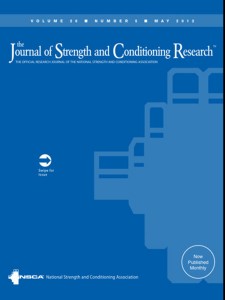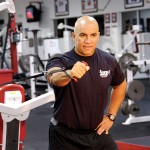By Jose Antonio PhD. How many sets and reps are best for strength? Size? Exercise performance? I’ll get to that. First a quick note.
The single best scientific journal in the field of strength and conditioning is the Journal of Strength and Conditioning Research or JSCR. It’s the official journal of the world’s largest academic organization dedicated to the science of strength and conditioning, the National Strength and Conditioning Association or NSCA. Now if they had any brand/marketing know-how, they should have named the journal the JNSCA. But that debate is for another time over a mug of beer and peanuts while watching a football game.
The latest issue had an intriguing article entitled the “Dose Response of 1, 3 and 5 Sets of Resistance Exercise on Strength, Local Muscular Endurance and Hypertrophy [1].” The reason the investigators performed the study was because there was a lack of studies comparing the effects of multiple sets (greater than 3 sets) on strength and size. And then the thought struck me as I was reading this paper. Who trains like this? And then I had neurons firing like crazy. Does ANYONE remember the work done 50 years ago by Dr. Richard Berger? Do we really need another study looking at the number of sets, number of reps, blah blah blah. Anyhow, be like Dorothy and follow me down the yellow brick road. To wit:
Some studies show that there’s no difference between 1 and 3 sets [2][3, 4].
Others show that 3 sets is better [5-7].
Are these really the pressing questions in the world of strength and condition science? Ok. That sounds a bit flippant. Let me rephrase. The study that looked at 1, 3 and 5 sets [1] had some good things and some things that reminded me of why nickel and dime science is needed (i.e. grad students need a project to graduate). The good part? It was a six month treatment period. Wow. Getting anyone to do anything for six months is tough. You’d have a better chance of finding a Parisian runway model at Lane Bryant than getting folks to  volunteer for a six month study. However, the subjects in the study weren’t resistance-trained per se. They did have prior workout experience with body weight exercises. So they weren’t the ideal subject pool (i.e. have extensive experience with heavy resistance training), but then again, they weren’t lazy college students whose idea of exercise is flexion of the 1st digit while holding an iPhone.
volunteer for a six month study. However, the subjects in the study weren’t resistance-trained per se. They did have prior workout experience with body weight exercises. So they weren’t the ideal subject pool (i.e. have extensive experience with heavy resistance training), but then again, they weren’t lazy college students whose idea of exercise is flexion of the 1st digit while holding an iPhone.
The bad part? Nobody trains like this. Oh. Except subjects in a study. 
The study volunteers did either 1, 3, or 5 sets (and there was a control that did traditional military calisthenic exercises) for 6 months (three times per week). I’m telling you. I’d be frickin’ bored after a couple weeks. You’d be hard pressed to find any athlete who does the same training program (i.e. same intensity, volume, exercise selection, rest interval, yada yada) for two weeks. Heck, following a basic periodization scheme you’d likely change it at LEAST every 3 weeks. Heck, I’d suggest changing it workout to workout.
So who trains like this? Nobody. Oh. Except subjects in a study.
And the 1 set versus multiple set debate? I’m baffled this is even a debate. Doing just one set to failure (or no failure) super-slow or super-fast or super-duper in-between speed makes absolutely no f’in sense. It would be like telling sprinters that all they’d need to do is one maximal sprint for their workout. Or tell the world-class miler that every workout consists of doing a 1-mile run at race pace. Have the 1-set proponents ever heard of training “volume?” 
Changes in training volume (as well as a myriad of other factors) are key to sustained improvements in exercise performance. Heck, even skinny runners figured out nearly a century ago that you needed to change training distance (i.e. volume) and intensity (i.e. speed, hill work etc) in order to improve. Only in the world of resistance training are there folks who actually think one set is all you need. Oh. Back up a sec. If you’re untrained, one set will suffice. And if you hate weight-training and have no concrete goals, then one set will suffice. But then again, untrained people will pretty much get a training effect from chewing on ice and watching grass grow.
I constantly chastise my students that they need to learn the history of exercise science. Otherwise, you’ll keep repeating the same shit over and over again. If you like this 1 set vs 3 sets versus 100 sets, go back and read the landmark work of Richard Berger [8][9]. We’re talking the 1960s for chrissakes. Flower power, free sex, doobies passed around like candy, and those oh-so-short mini-skirts. What a decade. Anyhow, Dr. Berger did a lot of initial  work comparing the number of sets and reps. Back then it was landmark. Doing this type of research today is like landing your dinghy on Plymouth Rock and saying you’ve discovered America.
work comparing the number of sets and reps. Back then it was landmark. Doing this type of research today is like landing your dinghy on Plymouth Rock and saying you’ve discovered America.
Now getting back to the recent JSCR study [1], in a nutshell here’s what they found. Multiple sets was better than a single set (for strength, size and endurance). Though did you notice that the control group gained fat-free mass (FFM)? In fact, the FFM increased from pre to post for all groups with no difference between groups. The control did traditional military calisthenics (i.e. body weight exercises). So does that mean zero sets of traditional weight training works too?
Also, will the next study feature 6 sets? 10 sets? Hey let’s go crazy and have a 20 set group. Where does the nickel and dime science end? Sorry. Grad students need projects to graduate.
If you are a strength and conditioning professional, it should be as clear as the big blue ocean that there are many programs that elicit gains in strength, size, and athletic performance. In a way, all programs work for a bit, but none work forever. If you know the basic principles of exercise training (i.e. overload, progression, specificity, detraining, variation etc), then you’ll be able to provide a safe and effective training program without boring the heck out of your athletes or clients. Let’s face it. If you ‘lose’ your athletes’/clients’ attention, then it doesn’t matter if you’re the best strength coach in the world. At that point, you’d have a better chance of getting them to memorize Shakespeare’s Macbeth. Thus, I’d highly recommend that you do not have them follow the same training program for six months (i.e. the current study at hand [1]).
 Bottom line for those with the attention span of a mosquito:
Bottom line for those with the attention span of a mosquito:
- Read the early studies of Dr. Richard Berger. Yeah yeah. I know it’s old. But just because it’s old, doesn’t mean it is no longer relevant.
- It would be wise to vary the # of sets (i.e. training volume), load (i.e. weight), exercise selection, exercise order, rest intervals, etc. Of course make sure that you tailor the program to the needs of the athlete. Heavy resistance training for bodybuilding is entirely different than other sports: MMA, sprinting, synchronized swimming, beach volleyball, etc.
- If you’re a grad student, I’ll forgive you for doing another sets/reps study.
- Given the choice between asking an experienced strength coach and a scientist for a
 training program, choose the strength coach (sorry my science-nerd friends!). They know the ins and outs and day to day trials and tribulations of what athletes go through. The best strength coaches are the ones that take what is learned in the lab and marry it to what they learn in the trenches.
training program, choose the strength coach (sorry my science-nerd friends!). They know the ins and outs and day to day trials and tribulations of what athletes go through. The best strength coaches are the ones that take what is learned in the lab and marry it to what they learn in the trenches. - Happy 2015. Hope you have a kick ass year.
Read these while sipping cocktails on the beach
1. Radaelli R, Fleck SJ, Leite T, Leite RD, Pinto RS, Fernandes L, Simao R: Dose Response of 1, 3 and 5 Sets of Resistance Exercise on Strength, Local Muscular Endurance and Hypertrophy. J Strength Cond Res 2014.
2. Bottaro, M et al. Resistance training for strength and muscle thickness: effect of number of sets and muscle group trained. Science and Sports 26: 259-264, 2011.
3. Hass CJ, Garzarella L, de Hoyos D, Pollock ML: Single versus multiple sets in long-term recreational weightlifters. Med Sci Sports Exerc 2000, 32:235-242.
4. Rhea MR: Determining the magnitude of treatment effects in strength training research through the use of the effect size. J Strength Cond Res 2004, 18:918-920.
5. Kraemer WJ, Ratamess N, Fry AC, Triplett-McBride T, Koziris LP, Bauer JA, Lynch JM, Fleck SJ: Influence of resistance training volume and periodization on physiological and performance adaptations in collegiate women tennis players. Am J Sports Med 2000, 28:626-633.
6. Paulsen G, Myklestad D, Raastad T: The influence of volume of exercise on early adaptations to strength training. J Strength Cond Res 2003, 17:115-120.
7. Rhea MR, Alvar BA, Ball SD, Burkett LN: Three sets of weight training superior to 1 set with equal intensity for eliciting strength. J Strength Cond Res 2002, 16:525-529.
8. Berger, R. Optimum repetitions for developing strength. Res. Q. 33:334-338. 1962.
9. Berger, R. Effect of varied weight training programs on strength. Res. Q. 33:168-181. 1962.
BIO – Jose Antonio earned his PhD at the University of Texas Southwestern Medical Center in Dallas Texas. HOW ‘BOUT DEM COWBOYS!


